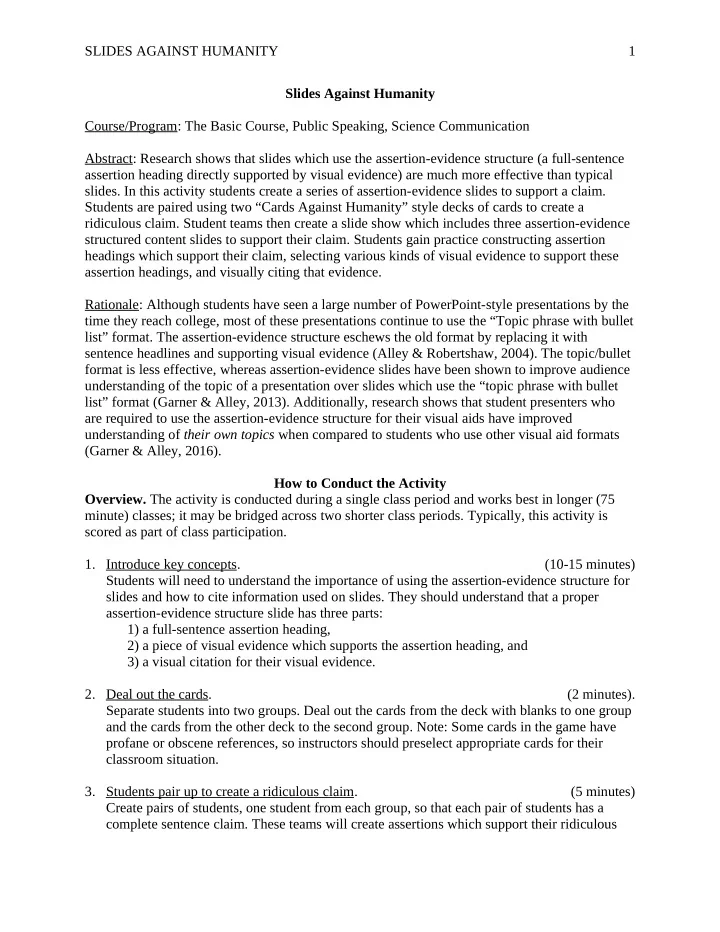

SLIDES AGAINST HUMANITY 1 Slides Against Humanity Course/Program: The Basic Course, Public Speaking, Science Communication Abstract: Research shows that slides which use the assertion-evidence structure (a full-sentence assertion heading directly supported by visual evidence) are much more effective than typical slides. In this activity students create a series of assertion-evidence slides to support a claim. Students are paired using two “Cards Against Humanity” style decks of cards to create a ridiculous claim. Student teams then create a slide show which includes three assertion-evidence structured content slides to support their claim. Students gain practice constructing assertion headings which support their claim, selecting various kinds of visual evidence to support these assertion headings, and visually citing that evidence. Rationale: Although students have seen a large number of PowerPoint-style presentations by the time they reach college, most of these presentations continue to use the “Topic phrase with bullet list” format. The assertion-evidence structure eschews the old format by replacing it with sentence headlines and supporting visual evidence (Alley & Robertshaw, 2004). The topic/bullet format is less effective, whereas assertion-evidence slides have been shown to improve audience understanding of the topic of a presentation over slides which use the “topic phrase with bullet list” format (Garner & Alley, 2013). Additionally, research shows that student presenters who are required to use the assertion-evidence structure for their visual aids have improved understanding of their own topics when compared to students who use other visual aid formats (Garner & Alley, 2016). How to Conduct the Activity Overview. The activity is conducted during a single class period and works best in longer (75 minute) classes; it may be bridged across two shorter class periods. Typically, this activity is scored as part of class participation. 1. Introduce key concepts . (10-15 minutes) Students will need to understand the importance of using the assertion-evidence structure for slides and how to cite information used on slides. They should understand that a proper assertion-evidence structure slide has three parts: 1) a full-sentence assertion heading, 2) a piece of visual evidence which supports the assertion heading, and 3) a visual citation for their visual evidence. 2. Deal out the cards . (2 minutes). Separate students into two groups. Deal out the cards from the deck with blanks to one group and the cards from the other deck to the second group. Note: Some cards in the game have profane or obscene references, so instructors should preselect appropriate cards for their classroom situation. 3. Students pair up to create a ridiculous claim . (5 minutes) Create pairs of students, one student from each group, so that each pair of students has a complete sentence claim. These teams will create assertions which support their ridiculous
SLIDES AGAINST HUMANITY 2 claim during the next step. For example, “I know not with what weapons World War III will be fought, but World War IV will be fought with … Taco Bell hot sauce.” 4. Student pairs create three content slides . (35 minutes) Allow these teams to work to create a total of three content slides: 1) a slide which uses an image as visual evidence, 2) a slide which uses a chart or graph as visual evidence, and 3) a slide which uses a brief direct quotation as visual evidence. They may choose to include a title slide and a reference slide in addition to their three content slides. Each content slide should have all three parts outlined in step one. 5. Students give a brief presentation which uses the visual aid . (10-15 minutes) Students show the visual aids that they have created to the rest of the class. This is a good time to point out the difference between visual evidence which supports an assertion and visual evidence that is merely related to an assertion but does not actually support it. 6. Debrief the Activity . (10-15 minutes) Students typically enjoy the activity and, because it can get pretty silly, it often helps them internalize the central ideas of the assertion-evidence structure. Evaluation: Slides Against Humanity has been conducted at three universities/colleges by several instructors, and all report “the activity was a hit.” Students learned how to implement the assertion evidence structure to their slides, engaged with the activity, and had lots of fun. Limitations: This activity requires students to have easy access to a computer lab or for students to have at least one personal laptops per group that they can use for the activity. It also requires a classroom projector and computer to display the end product. This often works best if teams save their projected visual aid onto jump drives. Variations: The activity may be conducted over two days with work outside the classroom. Allow students to select their own partners to create a claim they want to support. Instructors can determine how they would like students to “choose cards;” this portion has been conducted with a deck of cards, a list of phrases, and an interactive PowerPoint. References Alley, M. P., & Robertshaw, H. (2004, November). Rethinking the design of presentation slides: The importance of writing sentence headlines . Paper presented at the 2004 International Mechanical Engineering Conference and Exposition, Anaheim, CA. Garner, J. K., & Alley, M. P. (2013). How the design of presentation slides affects audience comprehension: A case for the assertion–evidence approach. International Journal of Engineering Education , 29 , 1564–1579. Garner, J. K., & Alley, M. P. (2016). Slide structure can influence the presenter’s understanding of the presentation’s content. International Journal of Engineering Education , 32 , 39–54.
SLIDES AGAINST HUMANITY 3 Appendix A: Examples of Student Slides
SLIDES AGAINST HUMANITY 4
Recommend
More recommend